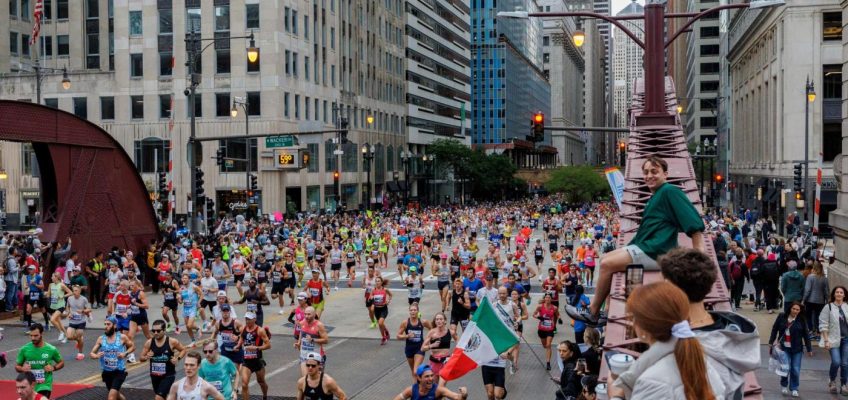Michael Guidotti will have his driver’s license on him when he runs the Chicago Marathon, just as he did during every training run since summer.
After the Trump administration escalated its immigration crackdown in the city, runners like Guidotti, 31, are worried they could become a target during Sunday’s race.
“Just knowing that I do come from a Hispanic background and also that I am somewhat darker, and that these individuals do seem to be targeting people of that demographic as well,” Guidotti said. “So it’s just an extra precaution that I’m taking that I have my driver’s license with me at all times.”
Questions have been swirling for weeks over whether Immigration and Customs Enforcement agents might target the marathon, which draws thousands of runners from around the world each year. Reflecting the unease, event organizers sent an email to participants Wednesday that referred to an immigration “Know Your Rights” page on the city’s website.
An ICE spokeswoman, Tanya Roman, said rumors that agents will be at the race are false.
“It’s absolutely ridiculous to ascertain that ICE would conduct immigration enforcement to intentionally disrupt the Chicago marathon,” she said in a statement. “These are the kind of rumors that fan the flames of dissent and result in unwarranted and dangerous riots like those in Portland, Chicago and Los Angeles.”
Related Articles
Federal judges in 2 states considering challenges to the government’s treatment of Abrego Garcia
Burkina Faso rejects proposal to accept deportees from the US
Judge blocks National Guard deployment in Illinois for 2 weeks
Bhargava, Sokol: Charging $100,000 for H-1B visas will cost the U.S. uncountable wealth
Arrivals of international students to the US dropped almost a fifth in August, data shows
Such assurances might not calm the fears of some participants, though.
Asked last week by a podcaster whether there would be “ICE enforcement” at the Super Bowl in February in California, Kristi Noem, who runs ICE’s parent agency, the Department of Homeland Security, said immigration officers would be “all over” the event.
DHS always heads the security effort at the Super Bowl, which is a bigger event. But Chicago has become a top target of the Trump administration, which has escalated immigration enforcement in the city through aggressive raids and tactics. Protesters at immigration facilities have been arrested, and President Donald Trump deployed the National Guard there to protect federal property and federal law enforcement, including ICE agents.
The Chicago Marathon is one of the biggest in the U.S. each year and is a major tourism draw for the city. There were 52,150 finishers last year, of which 15,000 were international participants, according to race organizers, who didn’t respond to requests for comment. Among foreign countries, Mexico was best represented, with 3,790 participants. It was followed by the U.K. (2,814), Canada (2,442) and Brazil (1,811).
The course winds through 29 neighborhoods, and more than a million people line the streets to support the runners.
Pilsen, a predominantly Latino neighborhood, is known for the energy that locals bring, with loud cheering and mariachi music blasting. But Enrique Rivera, who leads the neighborhood’s Venados Running Club and will be watching this year’s race, isn’t expecting the same energy.
“I’m absolutely sure that people are going to stay home,” he said. “There’s street vendors that aren’t out on the street doing their sales that impact their life. I’m sure they’re also going to be able to cut off recreational activities like cheering on runners.”
Rivera said his club is encouraging runners to stay informed, keep a list of important contacts on hand, and run in groups. Some club members have discussed what documentation they should bring.
“There is something in the air that says, ‘No, it doesn’t feel right,’” he said.
Critics say the immigration crackdown, which has swept up people who are legally living in the country, including U.S. citizens, is a sweeping government overreach, and that ICE engages in racial profiling.
Participant Amar Shah, 31, said that even though he was born and raised in the Chicago suburbs, he’s worried that his Indian heritage could make him vulnerable.
“I shouldn’t have any concerns from a legality standpoint, but I am a brown man. I have a beard,” he said. “I could be seen as someone who fits the stereotype of folks who are being targeted right now.”
Michael Rodriguez, the alderman for Chicago’s 22nd ward, which is home to a large Latino community, said businesses are “hurting” amid concerns about ICE, and this year’s race may bring less economic activity to the city than usual.
“I’m worried about those hundreds, maybe thousands of individuals from out of town, who come from internationally and throughout the nation to run,” Rodriguez said. “The hotel rooms they stay in, the restaurants they dine in, the money they spend in our city is going to be negatively impacted.”
“Some people might not come, others may choose not to spend their money,” he said.
Related Articles
Critically endangered baby black rhino makes its debut at Cleveland zoo
Firings of federal workers begin as White House seeks to pressure Democrats in government shutdown
What to know about National Guard deployments in Memphis and other cities
How a family-owned costume shop is keeping tariffs from making Halloween a nightmare
Blast at a Tennessee explosives plant leaves 19 people missing and feared dead, sheriff says
Mayor Brandon Johnson expressed confidence this week that the marathon would go off without a hitch, noting that roughly 3,000 runners from Mexico have signed up, “and I want them all to come.”
“I feel strongly about our ability to be able to hold large-scale events, and the strategic security measures that we’re putting in place are to ensure we continue to hold a reputation of hosting large-scale events,” the mayor said.
Associated Press reporters Jay Cohen in Chicago and Scott Bauer in Madison, Wisconsin, contributed to this report.




